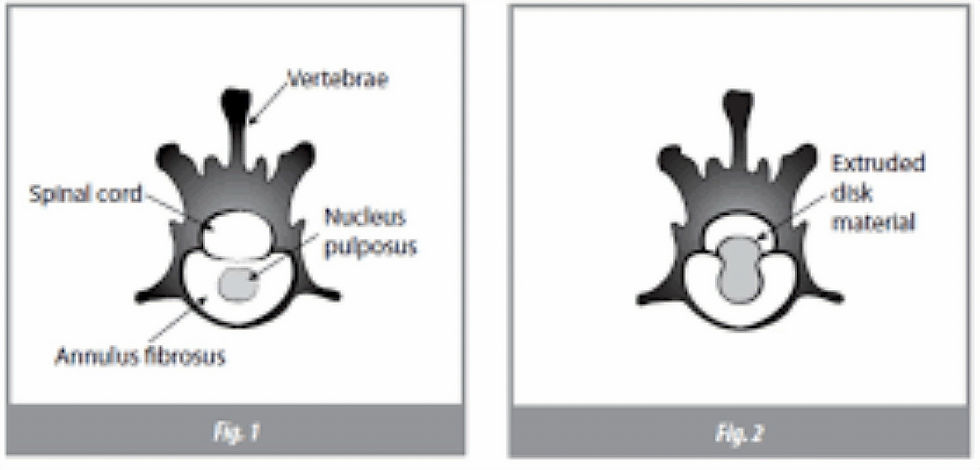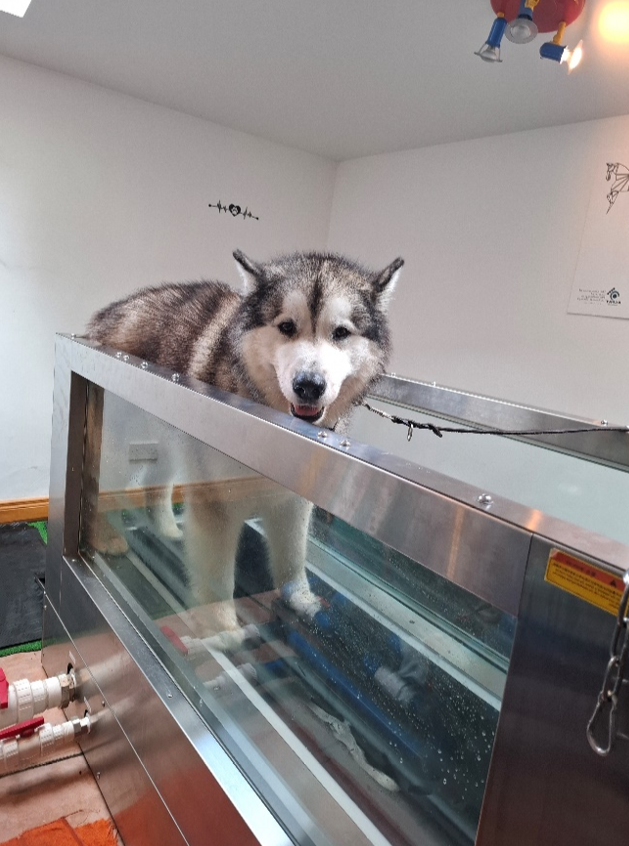Physiotherapy and Hydrotherapy for intervertebral disc disease (IVDD)
- Vet
- Jun 6
- 3 min read
Intervertebral discs are fibrocartilaginous cushions between the that allow movement, are supportive and act as shock absorbers. They consist of a fibrous outer rim, the annulus fibrosis, and a jelly like centre, the nucleus pulposus. Intervertebral disc degeneration results in reduced shock-absorption, and can ultimately lead to disc herniation and spinal cord compression.

What causes intervertebral disc disease and are there certain breeds at risk?
Intervertebral disc disease (IVDD) is an age-related, degenerative condition but some breeds can suffer disc problems from when they are young adult dogs. Disc degeneration is thought to occur because of loss of the disc to “hold water” becoming dehydrated. Discs can also herniate through trauma to the spine.

Conservative management of IVDD
Not every dog that is diagnosed with intervertebral disc disease will require surgery. These dogs can be effectively managed with rehabilitation. Early intervention and support is important, as is a thorough assessment and implementation of a staged rehabilitation treatment plan.
Physiotherapy aims
In the initial stage following diagnosis of IVDD the aims of physiotherapy will be to:
Reduce inflammation
Reduce pain and spasm
Maintain soft tissues flexibility
Improve core strength
Stimulate sensory input
Re-train postural responses
These above aims continue and progress with time depending on your dog’s progress. Aims will ultimately develop to include the following:
Further strengthen core stability
Facilitate effective gait
Increase exercise tolerance and overall cardiovascular fitness
Return to normal function

Physiotherapy options
Physiotherapy treatment may include laser, cold therapy, myofascial release, range of motion exercises and stretches, muscle stimulation, hydrotherapy and the vital home exercise programme and advice.
The following table is an example of a rehabilitation programme for IVDD
Timescale | Physiotherapy aims | Physiotherapy treatment |
0-4 weeks | Reduce inflammation Reduce muscle guarding Core activation and stability Muscle tone modulation Improve body awareness and sensation Maintain soft tissue length and joint mobility | Ice therapy Laser Heat therapy Myofascial release Whole body vibration Neuromuscular electrical stimulation Neuromuscular facilitation exercises Home exercise programme Hydrotherapy Advice for home care and using assistive devices Advice on careful supported handling techniques Passive assisted movements |
4-6 weeks | Core strengthen Increase motor control Improve body awareness and proprioception | Continue as above with appropriate progressions Home exercise program Hydrotherapy Controlled exercise |
6-12 weeks | Continue as above | Continue as above with appropriate progressions Cavaletti Balance cushions Assisted walking Home exercise program hydrotherapy |
12-20 + weeks | Increase exercise tolerance Improve gait pattern Improve higher function running, circles | Continue as above with appropriate progressions Home exercise program hydrotherapy |
Physiotherapy and Hydrotherapy for surgical management of IVDD
Rehabilitation is vital following surgery for intervertebral disc disease. Early intervention is crucial. The aims and treatment approach will vary depending on the level of disability your dog has and also the timescale following surgery. The key aims and treatment options are listed below. The chartered physiotherapist will constantly re-evaluate progress and adjust the programme accordingly.
Physiotherapy aims
Initial phase postop:
Reduce inflammation
Reduce muscle spasm
Maintain soft tissue flexibility
Increase sensory awareness
Increase strength
Advise owners of home care management requirements
Weeks 4-6:
Activate core muscles
Progress with the above aim
Improve balance and coordination
Enhance gait patterns
Week 6 ongoing:
Increase exercise tolerance and cardiovascular fitness
Increase core stability and strength
Return to normal function
Physiotherapy and hydrotherapy options
Possible options might include – laser, hot and cold therapy, massage, range of motion exercises and stretches, muscle stimulation, hydrotherapy, home exercise programme and advice about injury prevention. The following table is an example of a rehabilitation programme our chartered physiotherapists may use with your dog.*
Timescale | Physiotherapy aims | treatment options |
1-6 weeks | Reduce inflammation Reduce muscular guarding Maintain soft tissue length and flexibility Prevent bed sores (decubital ulcers) if recumbent Increase sensation and awareness of body position Increase strength Improve independence with postural sets Improve core stability Assist owner with management at home |
|
6-16 weeks | Muscle strength Core stability Functional gait re-education Sensory stimulation Modulation of muscle tone Improve body awareness | Hydrotherapy treadmill Baited stretches Stimulation brushing Supported standing Assisted stepping Standing weight shifts |
16 weeks- 6 months | Co-ordination Continue to progress strength, balance Correct functional movement Core strength and stability Improve mobility | Cavaletti Figure 8 and circle walking Sensory stimulation Balance cushion and wobble board exercises Hysrotherapy treadmill |
6-8 months | Increase exercise tolerance | Hills Gradual increase of exercises as above |
12 months+ | Return to normal activity | Off lead exercise |
*Please note that rehabilitation plans should only be followed under the guidance of a qualified rehabilitation professional, who will be able to provide a tailored plan based on the individual patient’s rehabilitation needs.
Hydrotherapy for IVDD dogs
Hydrotherapy is invaluable when rehabilitating dog patients following IVDD surgery. The buoyancy of the water supports the patient against gravity and allows effective exercise to take place. The warmth of the water provides a source of relief for any discomfort present and the hydrostatic pressure assists in swelling reduction.



Comments